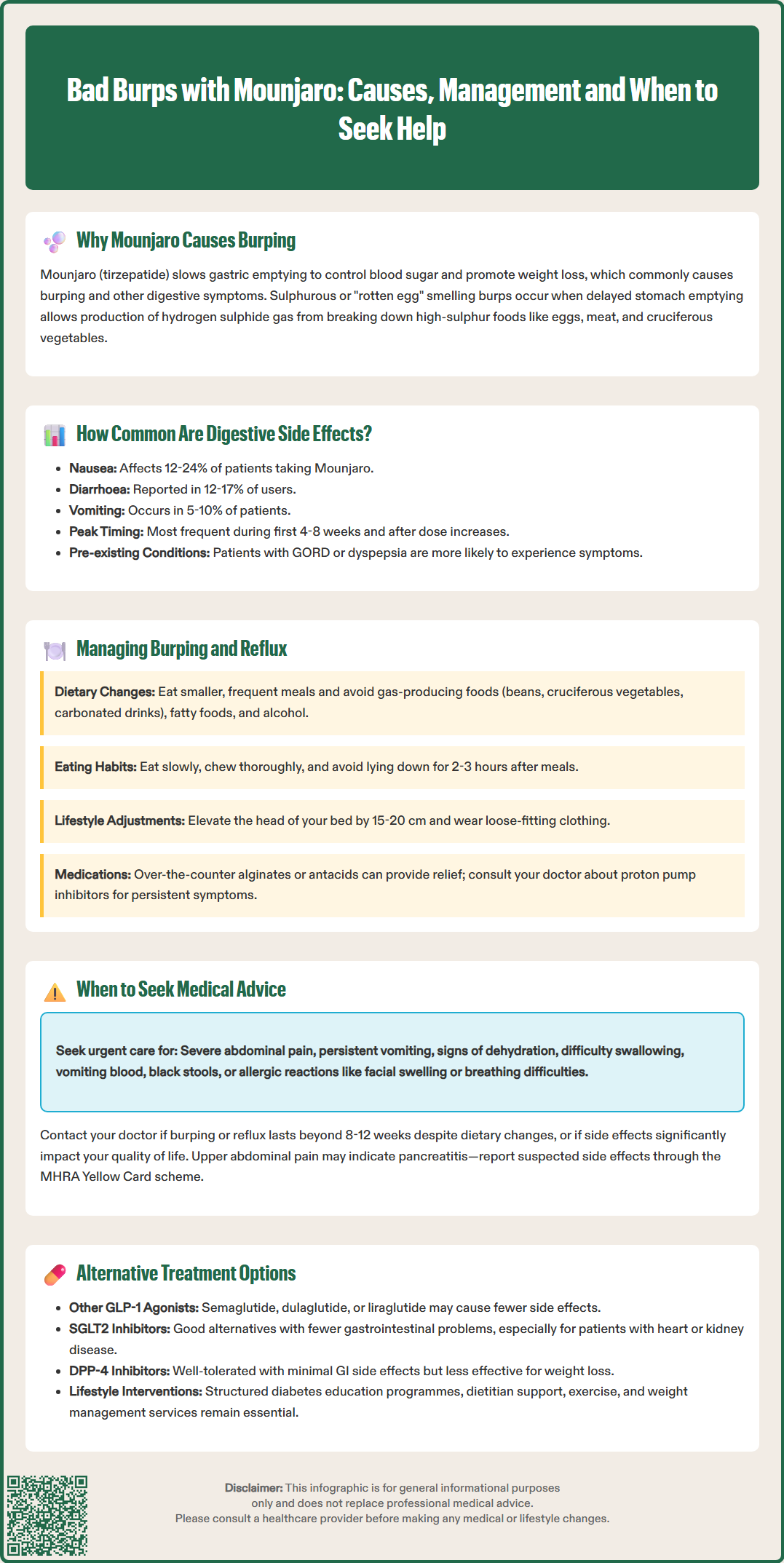
Bad burps with Mounjaro (tirzepatide) are a common gastrointestinal side effect experienced by many patients during treatment for type 2 diabetes. This dual GIP and GLP-1 receptor agonist works by slowing gastric emptying, which can lead to increased gas production and eructation, particularly during the initial weeks of therapy or following dose escalations. Whilst burping and associated digestive symptoms are typically mild to moderate and often improve over time, understanding why they occur and how to manage them effectively can significantly improve treatment tolerance and quality of life.
Quick Answer: Bad burps with Mounjaro occur because tirzepatide slows gastric emptying, leading to increased gas production and eructation, particularly during initial treatment or dose escalations.
Mounjaro (tirzepatide) is a dual glucose-dependent insulinotropic polypeptide (GIP) and glucagon-like peptide-1 (GLP-1) receptor agonist licensed in the UK for the treatment of type 2 diabetes mellitus. Its mechanism of action affects gastrointestinal motility, which explains why many patients experience burping (eructation) and other digestive symptoms.
Tirzepatide works by slowing gastric emptying—the rate at which food moves from the stomach into the small intestine. This delayed emptying helps regulate blood glucose levels and promotes satiety, contributing to weight loss. However, this slowed transit can lead to increased gas production and symptoms such as burping. This effect is typically most pronounced when initiating treatment or escalating the dose, and often diminishes over time as the body adapts.
The sulphurous or 'rotten egg' smell that some patients describe with their burps may result from hydrogen sulphide gas produced during the breakdown of certain foods, particularly those high in sulphur-containing amino acids (eggs, meat, cruciferous vegetables). The delayed gastric emptying caused by Mounjaro can contribute to these symptoms.
The combination of delayed gastric emptying and increased gas production can aggravate reflux symptoms and burping, especially during the initial weeks of treatment or following dose increases. According to the MHRA Summary of Product Characteristics (SmPC), gastrointestinal adverse reactions are among the most commonly reported side effects with tirzepatide treatment.

Gastrointestinal adverse effects are the most frequently reported side effects associated with Mounjaro therapy. In the pivotal SURPASS clinical trial programme, which informed the MHRA licensing decision, gastrointestinal symptoms affected a substantial proportion of participants.
According to the MHRA SmPC for Mounjaro, the following frequencies were observed:
Nausea: very common (≥1/10), affecting 12–24% of patients (dose-dependent)
Diarrhoea: very common (≥1/10), affecting 12–17% of patients
Vomiting: common (≥1/100 to <1/10), occurring in 5–10% of patients
Dyspepsia: common (≥1/100 to <1/10)
Eructation (burping): common (≥1/100 to <1/10)
Whilst burping itself was not always separately quantified in all trial reports, it falls within the broader category of upper gastrointestinal symptoms. The severity of these symptoms is typically mild to moderate, and most patients experience improvement over time as their bodies adapt to the medication.
Important considerations include:
Gastrointestinal side effects are most common during the first 4–8 weeks of treatment
Symptoms often intensify temporarily following dose escalation
Individual susceptibility varies considerably based on baseline gastric function, diet, and concurrent medications
Patients with pre-existing GORD or functional dyspepsia may be more prone to burping and reflux symptoms
According to NICE guidance (NG28), healthcare professionals should counsel patients about expected side effects before initiating GLP-1 receptor agonist therapy, ensuring realistic expectations and appropriate management strategies are in place from the outset.

Mounjaro® is the most innovative GLP-1 medication proven to dramatically curb appetite, hunger, and cravings to help professional men achieve substantial weight loss.
Start Here
Wegovy® is a weekly injectable GLP-1 medication with proven effectiveness in reducing appetite, hunger, and cravings to help busy professionals lose significant weight.
Start HereDietary modifications represent the first-line approach to managing burping and digestive discomfort whilst taking Mounjaro. Patients should consider:
Eating smaller, more frequent meals rather than large portions, which reduces gastric distension and gas production
Avoiding gas-producing foods such as beans, lentils, cruciferous vegetables (broccoli, cauliflower, cabbage), carbonated beverages, and foods high in sulphur
Reducing fatty and fried foods, which further delay gastric emptying and may exacerbate symptoms
Limiting alcohol and caffeine, both of which can worsen reflux symptoms
Eating slowly and chewing thoroughly to reduce air swallowing (aerophagia)
Avoiding lying down within 2–3 hours after eating to minimise reflux
Lifestyle adjustments can also provide relief:
Elevating the head of the bed by 15–20 cm may reduce nocturnal reflux and burping
Maintaining a healthy weight (though Mounjaro itself promotes weight loss)
Wearing loose-fitting clothing around the abdomen
Managing stress, which can affect gastric motility
Pharmacological options may be appropriate for persistent symptoms:
Alginates/antacids (e.g., alginate raft formulations) can provide symptomatic relief for reflux-related burping
Proton pump inhibitors (PPIs such as omeprazole or lansoprazole) may be prescribed for more significant GORD symptoms, though these should be used at the lowest effective dose for the shortest duration necessary per NICE CKS guidance
Simeticone (an anti-foaming agent) may help reduce gas, though evidence for its efficacy is limited
Following the SmPC recommendations, patients should start Mounjaro at 2.5 mg weekly for 4 weeks, then increase by 2.5 mg every 4 weeks as tolerated. If symptoms are troublesome, discuss with your healthcare provider about temporarily maintaining the current dose or reducing to a previously tolerated dose.
Women using oral contraceptives should note that tirzepatide may reduce contraceptive efficacy, particularly after initiation or dose increases. Additional contraceptive methods are advised for 4 weeks after starting treatment or increasing the dose.
Whilst burping and mild digestive discomfort are common and generally manageable side effects of Mounjaro, certain symptoms warrant prompt medical assessment. Patients should contact their GP or diabetes care team if they experience:
Red flag symptoms requiring urgent evaluation:
Severe, persistent abdominal pain, particularly in the upper abdomen, which could indicate pancreatitis (a rare but serious adverse effect of GLP-1 receptor agonists)
Severe right upper quadrant pain, fever, or jaundice, which may suggest gallbladder disease (cholelithiasis or cholecystitis)
Persistent vomiting preventing adequate fluid or medication intake, risking dehydration
Signs of dehydration: reduced urination, dark urine, dizziness, confusion, or extreme thirst
Difficulty swallowing or sensation of food becoming stuck
Vomiting blood or passing black, tarry stools (melaena), suggesting gastrointestinal bleeding
Rapid, unintended weight loss with systemic symptoms such as fatigue or weakness
Severe heartburn unresponsive to antacids or worsening reflux symptoms
Signs of allergic reaction: swelling of face/lips/tongue, difficulty breathing, widespread rash
Symptoms requiring routine medical review:
Burping or reflux symptoms persisting beyond 8–12 weeks despite dietary modifications
Gastrointestinal symptoms significantly affecting quality of life or nutritional intake
New or worsening symptoms after dose escalation that do not improve within 2–3 weeks
Concerns about medication adherence due to side effects
For urgent advice, contact your GP, NHS 111, or in emergencies (severe pain with systemic illness, significant bleeding, or breathing difficulties), call 999 or attend A&E.
The MHRA Yellow Card scheme (https://yellowcard.mhra.gov.uk/) allows patients and healthcare professionals to report suspected adverse drug reactions. Reporting helps regulatory authorities monitor the safety profile of medications like Mounjaro in real-world use.
Patients should never abruptly discontinue Mounjaro without medical guidance, as this may affect glycaemic control. Any decision to adjust dosing or switch medications should be made collaboratively with the prescribing clinician.
If burping and gastrointestinal side effects remain intolerable despite management strategies, several alternative treatment options exist for type 2 diabetes, though the choice depends on individual clinical circumstances, glycaemic control targets, and comorbidities.
Other GLP-1 receptor agonists may be better tolerated:
Semaglutide (Ozempic) – a selective GLP-1 receptor agonist without GIP activity, which some patients tolerate differently
Dulaglutide (Trulicity) – once-weekly injection with a potentially different side effect profile
Liraglutide (Victoza) – daily injection that may allow more gradual dose titration
It should be noted that all GLP-1 receptor agonists affect gastric emptying to some degree, so gastrointestinal symptoms may still occur, though individual responses vary.
Alternative medication classes recommended by NICE (NG28) include:
SGLT2 inhibitors (e.g., dapagliflozin, empagliflozin) – particularly beneficial for patients with established cardiovascular disease, heart failure, or chronic kidney disease
DPP-4 inhibitors (e.g., sitagliptin, linagliptin) – generally well-tolerated with fewer GI side effects, though less effective for weight reduction
Metformin – remains first-line therapy if not already prescribed, though it can cause diarrhoea in some patients
Insulin therapy – may be necessary for some patients, particularly those with inadequate beta-cell function
If switching to insulin or sulfonylureas, be aware that reduced appetite from persistent GI symptoms may increase hypoglycaemia risk; close monitoring and dose adjustment with clinical supervision is essential.
Non-pharmacological approaches remain fundamental:
Structured diabetes education programmes (e.g., DESMOND, available through NHS diabetes services)
Medical nutrition therapy with a registered dietitian
Physical activity programmes tailored to individual capability
Weight management services for those with obesity
The decision to switch from Mounjaro should be made collaboratively between patient and clinician, weighing the benefits of glycaemic control and weight loss against the impact of side effects on quality of life. Regular HbA1c monitoring will guide treatment adjustments to ensure diabetes remains well-controlled with whichever regimen is ultimately selected.
Burping and digestive symptoms with Mounjaro are typically most pronounced during the first 4–8 weeks of treatment and often diminish as the body adapts. Symptoms may temporarily intensify following dose escalations but usually improve within 2–3 weeks.
Yes, alginates and antacids can provide symptomatic relief for reflux-related burping. For more significant symptoms, proton pump inhibitors may be prescribed by your healthcare provider, though these should be used at the lowest effective dose for the shortest necessary duration.
Never abruptly discontinue Mounjaro without medical guidance, as this may affect blood glucose control. If symptoms are troublesome, discuss with your healthcare provider about temporarily maintaining your current dose, implementing dietary modifications, or considering alternative treatments if symptoms remain intolerable.
All medical content on this blog is created based on reputable, evidence-based sources and reviewed regularly for accuracy and relevance. While we strive to keep content up to date with the latest research and clinical guidelines, it is intended for general informational purposes only.
DisclaimerThis content is not a substitute for professional medical advice, diagnosis, or treatment. Always consult a qualified healthcare professional with any medical questions or concerns. Use of the information is at your own risk, and we are not responsible for any consequences resulting from its use.